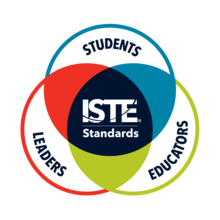 | |
| Abbreviation | ISTE |
|---|---|
| Formation | 1979 |
| Founder | David Moursund and a group of K-12 and University of Oregon educators |
| Type | 501(c)(3) non-profit |
| Purpose | Education, Membership organization |
| Headquarters | Washington, DC, United States |
Area served | Worldwide |
Key people | Rand Hansen, president Richard Culatta, CEO |
Staff | 75 |
| Website | iste |
Formerly called | The International Council for Computers in Education (ICCE) |

The ISTE Standards, formerly known as the National Educational Technology Standards (NETS), are standards for the use of technology in teaching and learning (technology integration).[1] They are published by the International Society for Technology in Education (ISTE), a nonprofit membership association for educators focused on educational technology. They include the ISTE Standards for Students, which list skills and attitudes expected of students.[2] They also include the ISTE Standards for Educators, ISTE Standards for Administrators, ISTE Standards for Coaches and ISTE Standards for Computer Science Educators.
The ISTE Standards are designed to work with learning models such as Technological Pedagogical Content Knowledge (TPACK)[citation needed] and support the implementation of content-area standards, including the Common Core State Standards.[3] They are often affiliated with new approaches to education, including project-based learning,[4] blended learning, and the flipped classroom model.
- ^ Stager, Gary. "Refreshing the ISTE Technology Standards," District Administration, June 2007
- ^ "5 Things Teachers Should Know About the ISTE Tech Standards," Concordia University-Portland blog, Feb. 1, 2013
- ^ "Common Sense Media, Standards Alignment". Retrieved 2016-08-20.
- ^ Barron, Ann (2003-12-01). "Large Scale Research Study on Technology in K-12 Schools". Journal of Research on Technology in Education. 35 (4): 489–507. doi:10.1080/15391523.2003.10782398.